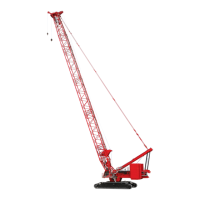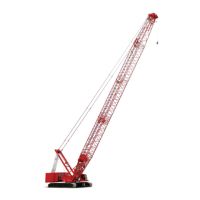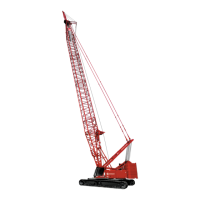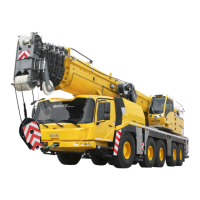Manitowoc Published 09-09-16, Control # 229-09 7-3
MLC650 SERVICE/MAINTENANCE MANUAL POWER TRAIN
NOTE: Do not use this test method if the battery has been
recently charged by a charger or alternator. Recent
charging places a high surface charge voltage,
which is not a true indication of actual battery
voltage.
Table 7-2. Open Circuit Voltage
Consult the manual provided with the test meter for detailed
test information.
Troubleshooting—Slow Cranking
If the starter cranks too slowly and the battery is charged and
in good condition, do a voltage-drop test to make sure that
the starter connections are good.
When cranking, a voltage drop of more than 0.2 volts
between the starting motor cable and ground can cause hard
starting regardless of a battery’s condition. The voltage drop
can be caused by a poor contact between the cable terminal
and ground or between the clamp terminal and the battery
post. Also, poor start-switch contacts and frayed, broken, or
corroded cables can be the cause.
Quarterly Battery System Maintenance
• Thoroughly clean the batteries and the holder with a
baking soda/water solution.
• If provided, make sure the drain holes are open in the
holder. If water collects in the holder, drill some drain
holes.
• Clean the posts and terminals. The posts can be lightly
coated with petroleum jelly to prevent corrosion.
• Make sure that the hold-downs are in good condition.
Replace faulty parts.
• Replace frayed, broken, or corroded cables.
• Replace the batteries if their containers are cracked or
worn to the point that they leak.
• Ensure a good tight contact between the clamp
terminals and the battery posts.
• Make sure the hold-downs are tight enough to prevent
battery movement but not so tight to cause distortion.
Charging
NOTE: If the crane is equipped with the optional charger,
see APU Operation Manual.
1. Remove the batteries or disconnect all the crane wiring
from the batteries.
2. Read and follow the charger manufacturer’s
instructions.
Always wear eye protection when servicing batteries.
NOTE: The battery should be at room temperature when
recharging. Never attempt to recharge a frozen
battery.
3. Clean the top of the battery to help prevent dirt entering
the cells.
4. Verify the plates are covered with electrolyte. If the level
is low, add distilled water to bring the level just to the top
of the plates. Use a clean funnel. Re-check after
charging.
• The maximum charge rate in amperes should be no
more than 1/3 of the battery’s reserve capacity
minute rating.
State of Charge Specific Gravity
Approximate
Open-Circuit
Voltage
(24V System)
100% 1.260 25.2
75% 1.230 24.8
50% 1.200 24.4
25% 1.170 24.0
0% 1.110 23.6
Item Description
1 Test Leads on Battery Terminals
2 Voltmeter
FIGURE 7-2

